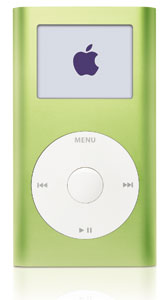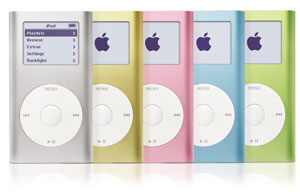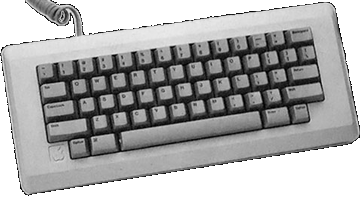iPod mini

Essentials
Family: iPod
Codename: ?
Minimum OS: iPod mini OS 1.0
Maximum OS: iPod mini OS 1.4.1
Introduced: January 2004
Terminated: February 2005
Processor
CPU: ARM7TDMI
CPU Speed: dual 80 MHz embedded
FPU: none
Register Width: 32-bit
Data Bus Width: 32-bit
Address Bus Width: 32-bit
ROM: 32 MB
Onboard RAM: 32 MB
Maximum RAM: 32 MB
Video
Screen: 1.67" backlit LCD
Max Resolution: 1-bit 138x110
Storage
Hard Drive: 4 GB 4200 RPM
ATA Bus: ATA-66
Input/Output
USB: via Dock Connector
Firewire: via Dock Connector
Audio Out: stereo 16 bit mini
Speaker: clicker
Miscellaneous
Dimensions: 3.6" H x 2.0" W x 0.5" D
Weight: 0.225 lbs.

Announced in January 2004, the iPod mini was the height and width of a business card. Built around a 1" 4 GB hard drive, the iPod mini raised the bar for portability in a hard disk music player. It was small enough to wear comfortably on an arm band, but large enough to hold nearly 1,000 songs. For its small size, Apple charged a premium: the 4 GB iPod mini was $249, only $50 less than a 15 GB full size iPod. Apple believed that its small size and consumer appeal would make up for its high price. As Apple hoped, iPod mini's sold extremely well. So well, in fact, that demand vasty outstripped supply long into the summer months.
The iPod mini was available in five metalic colors: silver, gold, pink, blue and green. it was based around the PortalPlayer PP5020 System-on-a-chip, the same chip that would later power the iPod (Click Wheel). In order to fit everything in such a small package, Apple had to change the layout of the buttons from the exiting iPod design. All buttons were again made mechanical, and the four buttons which had previously been at the top of the front face were now placed underneath the scroll wheel. The result, which Apple called a "ClickWheel" allowed users to use the wheel as a touch-sensitive scroll wheel, or push on the four corners to click the buttons.
Picture Credits:
Apple, Inc.
